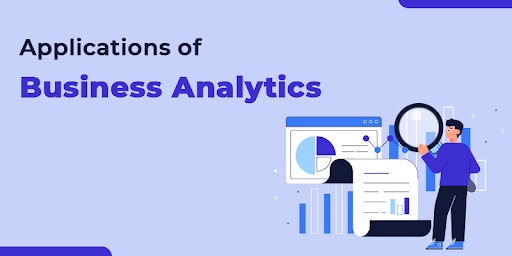
Applications of Business Analytics
Everything, including how businesses run and develop alternatives and procedures, has changed. Understanding how data is produced by digital systems is necessary for making intelligent judgments. If you are someone who wishes to pursue a career in the industry, then we propose that you enroll in a Business Analyst Training in order to learn about it all.
But before digging deep into the depth of Business Analytics and its applications, let us first understand what is meant by the term itself!
What is Business Analytics?
The process of transforming data into meaningful information to enhance company choices is known as business analytics.
Among the methods typically used to derive insights from data are information management, data visualization, predictive analysis, data collecting, prediction modeling, and efficiency.
Even while quantitative, comparative, and evaluative approaches are very essential, the ultimate goal of business analytics is to develop data visualizations that explain your results and affect business choices. Success in this sector requires a good communication style as well as technical expertise.
But, who is a Business Analyst and what are the responsibilities one has to fulfill?
Who is a Business Analyst?
In today’s corporate sector, business analysts are already playing a critical role, the choices and actions made by business analysts have a small yet discernible impact on the company’s financial prospects. They have to make sure that the data visualizations explain their results and directly influence the company decisions, even if quantitative, comparison, and evaluative methods are quite important.
The major responsibilities of a business analyst’s include the following:
- Installing the brand-new features.
- Recognizing and adapting to the nature of the corporate world.
- Analyzing the results of adding additional features.
- Take the steps or activities necessary to enable the launch of new features should be determined.
- Make the next features that will be used.
Applications of Business Analytics
- CUSTOMER RELATIONSHIP MANAGEMENT (CRM)
Building and managing relationships with customers for an organization is called customer relationship management, or CRM.
Client relationship management may benefit from the use of business analytics to better understand the customer base and adopt matching strategies. This considerably boosts the organization’s revenue and sales.
Through the use of business analytics approaches, it is possible to gather and analyze data about customers’ buying habits, wants, and behaviors as well as their problems, feedback, and other indications. The development of enduring and devoted client connections with the company can then be aided by these signs.
- Risk and Fraud Detection
Business Analytics may have been used for the first time to detect fraud. Because they already had a ton of consumer data available, they used Business Analytics. To determine the possibility of default, data analysis was employed to evaluate recent expenditure trends and consumer profiles. Over time, fraud and risk decreased as a consequence.
- Education
Currently, data analysts are especially needed for applications involving Business Analytics in education. Adaptable learning, innovative inventions, adaptive content, etc. are where it is most frequently applied. is the evaluation, collection, examination, and description of data about students and their unique situations for the sake of understanding and simplifying learning and the environments in which it occurs.
- HUMAN RESOURCES MANAGEMENT (HRM)
The method or practice of strategically managing, hiring, organizing, training, and guiding people within a company is known as human resource management. Business analytics is used by HR professionals in a variety of ways.
It assists them in evaluating vast volumes of data to comprehend the demands and complaints of employees and afterwards provide them with the necessary assistance.
HR may utilize business analytics to find the best applicants, estimate compensation, and track industry-wide trends in retention rates.
- Manufacturing
Unexpectedly, the manufacturing sector benefits from business analytics as well. Here are some examples of how Tata Steel uses business analytics to advance its operations:
- Monitoring and streamlining the production process.
- Improve logistics.
- Reducing risks and removing obstacles.
- Tata Steel has begun recruiting additional business analytics specialists for its production process after seeing the success they have had with the technology.
Now that we have covered What is Business Analytics, who is Business Analyst and it’s responsibilities along with the applications Business Analytics, it’s time to know What are the various types in which Business Analytics is segregated:
- Descriptive Analytics:
Descriptive Analytics makes it possible to have a thorough understanding of both the past and the present using data aggregation and data mining techniques.
Many companies hire descriptive analytics to take a closer look at consumer behavior and determine how best to focus marketing campaigns at those customers.
- Diagnostic Analytics:
Concentrates on historical performance to identify the factors behind certain patterns.
Drill-down, data mining, data discovery, and correlation are methods used to ascertain the cause of particular events. After determining the likelihood of the event and its likely causes, classification and regression algorithms are used.
- Predictive Analytics:
Predictive Analytics uses statistical models and machine learning techniques to predict and assess future outcomes
Models that estimate the probability of particular outcomes are frequently created using the findings of descriptive analytics.
This kind is frequently used by sales and marketing teams to predict consumer attitudes based on social media data about particular customers.
- Prescriptive Analytics:
Analytics that makes recommendations based on prior performance is known as prescriptive analytics. This kind of business analytics can suggest the precise activities that should be taken in order to get the greatest outcome in addition to determining results. This is usually accomplished using deep learning and complex neural networks.
Future of Business Analytics
Augmented Analytics
The most popular business analytics trend now among corporations and the government is augmented analytics. This is the application of machine learning and natural language processing to improve business intelligence, Business Analytics, and data sharing. The goal of the entire process is to make business analytics simpler.
Large-scale automation
Businesses are attempting to automate massive data flows that might occasionally be too complicated to comprehend. Data pipelines and business-ready data kept in a user-friendly OLAP data warehouse will continue to play a more and bigger role. In other words, businesses would move closer to making data automation a reality to help decision-making by looking forward to storing the multidimensional data received from several unconnected sources under a shared storage platform.
Visualization of data
Making business data visually attractive and current is the process of data visualization. A business analyst may better grasp the data and draw the appropriate conclusions from it with the aid of data visualization. Because the human brain perceives data visually, it is a terrific tool for the company to forecast future trends.







